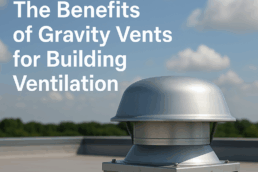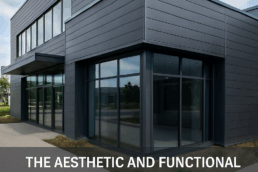When it comes to construction and architectural design, the small details often make the biggest difference. One such detail that is frequently overlooked but critically important is parapet wall coping. Parapet walls are the extensions of walls at the edge of roofs, terraces, or balconies. While they serve various purposes, their protection is highly important. This is where parapet wall coping comes into play.
Parapet wall coping is an essential component that combines functionality with aesthetic appeal. Imagine constructing a beautiful building only to see it deteriorate over time due to water damage or structural instability. The right parapet wall coping not only prevents these issues but also enhances the overall look of the structure. It contributes to a cohesive and finished appearance.
In this blog, we look into why parapet wall coping is crucial for your structure. We’ll explore its various benefits, the different types available, and how choosing the right coping can safeguard your building while adding to its visual appeal. Understanding the importance of parapet wall coping can help you make informed decisions that enhance both the durability and beauty of your construction projects.
What is Parapet Wall Coping?
Parapet wall coping refers to the protective cap placed on top of parapet walls. These walls are often found at the edges of roofs, terraces, or balconies and act as barriers to prevent water penetration and damage. However, the role of parapet wall coping extends beyond mere protection. It serves a dual purpose: safeguarding the building from the elements while adding a polished, aesthetically pleasing finish to the structure.
Parapet walls themselves are critical architectural elements. They provide safety and functional barriers, especially on rooftops and terraces. They help to shield the building’s edges from wind, rain, and debris. However, without adequate protection on top, they are susceptible to damage. This is where coping comes in and acts as a shield that directs water away from the wall. It prevents seepage that can lead to structural issues such as erosion, cracking, and mold growth.
The coping cap can be made from various materials, each offering unique benefits and aesthetic qualities. The choice of material often depends on the architectural style of the building, the desired look, and the specific environmental challenges the structure might face
Benefits of Parapet Wall Coping
Parapet wall coping offers multiple benefits that are essential for both the protection and aesthetic enhancement of your structure. Below, we explore these benefits in detail.
Weather Protection
One of the most significant benefits of parapet wall coping is its ability to protect against weather elements. Parapet walls are continuously exposed to harsh weather conditions such as rain, snow, ice, and even intense sunlight. Without proper protection, these elements can cause severe damage over time. Water infiltration is a common issue and may lead to internal leaks, mold growth, and structural degradation.
Coping acts as a shield, directing water away from the parapet wall and preventing it from seeping into the building materials. This protective barrier ensures that water is not able to penetrate the structure. Thereby, avoiding erosion and maintaining the integrity of the wall.
Additionally, in colder climates, coping helps to prevent freeze-thaw damage. This is damage caused when trapped water freezes and expands, causing cracks and other damage. By protecting against these weather-related issues, parapet wall coping extends the lifespan of the building and reduces maintenance costs.
Aesthetic Appeal
Beyond its functional benefits, parapet wall coping significantly enhances the aesthetic appeal of a building. The top of a parapet wall can often appear unfinished or plain. However, with the addition of well-designed coping, the structure gains a polished and refined look. This aesthetic improvement contributes to the overall architectural harmony and can increase the perceived value of the property.
Coping comes in various materials and finishes and allows for customization to match the building’s design. Whether you prefer the sleek look of metal coping, the classic appeal of stone, or the versatile options provided by concrete, parapet wall coping can be customized to complement and enhance any architectural style. This customization adds a unique touch to the building, which makes it stand out and creates a lasting impression.
Structural Integrity
Another critical benefit of parapet wall coping is the enhancement of structural integrity. Parapet walls are inherently vulnerable due to their exposed position. Over time, without proper protection, the materials can degrade. This may lead to instability and potential failure. Coping helps to maintain the structural integrity of the parapet wall by covering its top and preventing water from seeping in and causing damage.
Furthermore, coping adds physical strength to the parapet wall. Securing the top of the wall helps to hold the materials together. This prevents movement and shifting that could compromise the wall’s stability. This added strength is particularly important in regions prone to high winds or seismic activity, where structural integrity is highly important. Coping ensures that the parapet wall remains solid and secure for the overall safety and durability of the building.
Types of Parapet Wall Coping
Choosing the right type of parapet wall coping is essential to maximize its benefits. Different materials offer various advantages in terms of durability, aesthetics, and cost. Here, we explore the most common types of parapet wall coping:
Metal Coping
Metal coping is a popular choice due to its durability and low maintenance. It is particularly favored for modern and contemporary designs. Metal coping can be fabricated from various materials, including:
- Stainless Steel: Known for its resistance to corrosion and staining, stainless steel is ideal for areas with high exposure to moisture and harsh weather conditions. It offers a sleek, polished look that complements modern architectural styles.
- Aluminum: Lightweight and resistant to rust, aluminum is an excellent choice for buildings in coastal areas or places with high humidity. It can be easily formed into different shapes and profiles for design flexibility.
- Copper: Copper provides a distinctive, elegant look that develops a natural patina over time. This feature of copper can add character to the building. It is durable and has excellent corrosion resistance, making it suitable for both traditional and contemporary structures.
Metal coping is not only durable but also versatile and available in various finishes and colors. This versatility allows it to match or contrast with other building materials to enhance the overall aesthetic appeal.
Stone Coping
Stone coping offers a classic look and long-lasting durability. It is often used in traditional and historic buildings and imbues a timeless appeal. Common types of stone used for coping include:
- Granite: Extremely durable and resistant to weathering, granite is ideal for structures that require robust, long-lasting coping. Its natural beauty and variety of colors make it a popular choice for both traditional and modern buildings.
- Limestone: Limestone offers a softer, more uniform appearance. It is durable but slightly more porous than granite. So, it may require sealing in certain climates to prevent water absorption.
- Sandstone: Known for its natural, rustic look, sandstone adds a unique texture to the building. It is durable and available in various colors. This makes it suitable for a range of architectural styles.
Stone coping provides a natural, elegant finish that enhances the aesthetic appeal of any building. Its durability ensures that it remains an attractive feature for many years.
Concrete Coping
Concrete coping is a cost-effective and versatile option suitable for various architectural styles. It offers several benefits, including:
- Customization: Concrete can be molded into different shapes and sizes, allowing for extensive customization. It can be finished in multiple ways, such as smooth, textured, or stamped to mimic other materials like stone or brick.
- Durability: Concrete is inherently durable and can withstand extreme weather conditions. It can be reinforced with steel for additional strength. Its reliability makes it suitable for buildings in seismic zones or areas with high wind exposure.
- Versatility: Concrete coping can be colored and finished to match or complement other building materials. This versatility makes it a popular choice for both residential and commercial buildings.
Concrete coping is not only durable and cost-effective but also offers a wide range of design possibilities. Its ability to be customized makes it an excellent choice for projects that require specific design elements or finishes.
Parapet wall coping is essential for protecting your structure from weather damage and enhancing its aesthetic appeal. By choosing the right type of coping, whether it be metal, stone, or concrete, you can ensure the longevity and beauty of your building. Investing in quality parapet wall coping is a smart decision that pays off in the form of a durable, visually appealing, and structurally sound building.
At C & J Metal Products, we specialize in custom sheet metal fabrication. Our expertise includes high-quality metal coping for parapet walls. Our expertise and dedication to craftsmanship ensure that your project is completed to the highest standards. Contact us today to learn more about our services and how we can help protect and enhance your building with our top-of-the-line metal coping solutions.



